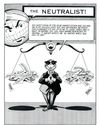Prøve GULL - Gratis
A CITY BUILT BY IMMIGRANTS—AND BEER
Reason magazine
|August - September 2025
FAR BELOW DOWNTOWN Cincinnati, you'll find large stone-and brick-walled caverns with dirt-strewn floors. Their great arched passageways loom over piles of century-old rubble, vast vats that once overflowed with beer, and recently added stairways to assist tourists passing through.

As with so much in Cincinnati, we can chalk up these places to beer-loving German immigrants. The caverns were built for storing lager back before refrigeration was widespread. Unlike ales, lagers must be aged and stored at temperatures below 40 degrees. For the city's burgeoning German population to make the sorts of lagers they had known back home, they had to dig deep.
“The cities that made a lot of beer between 1850 and 1880, they all had lagering cellars,” says Michael Morgan, author of Over-the-Rhine: When Beer Was King. In many places, these subterranean caverns would later be filled in. But not so here.
Curious Cincinnatians and tourists can now traverse recently rediscovered lagering cellars on tours organized by the Brewing Heritage Trail or American Legacy Tours. For a less rustic experience, they can visit Ghost Baby, a cocktail bar and music venue located in a renovated lagering cellar four stories underground.
A trip to—or below—Cincinnati’s historic brewery district will take you to Over-the-Rhine, just outside Cincinnati's city center. When German immigrants started flocking to the city in the 1800s, many settled just north of the Miami-Erie Canal cutting through central Cincinnati. Locals began referring to the canal, derisively, as “the Rhine,” and the German-heavy neighborhood just north of it as “over the Rhine.” The nickname stuck.
Today this is often relayed as merely a charming little anecdote. But it hints at deep tensions between the city’s earliest settlers and the huge wave of immigrants to come.
CINCINNATI'S POPULATION BALLOONED throughout the 19th century, from 2,540 residents in 1810 to 115,435 in 1850, when it ranked as the sixth-largest American city. By 1900, it had 325,902 residents, according to the U.S. Census Bureau.
Denne historien er fra August - September 2025-utgaven av Reason magazine.
Abonner på Magzter GOLD for å få tilgang til tusenvis av kuraterte premiumhistorier og over 9000 magasiner og aviser.
Allerede abonnent? Logg på
FLERE HISTORIER FRA Reason magazine

Reason magazine
A Nostalgic Read for Foreign Policy Elites
IF YOU WERE looking for a human avatar of America's unipolar moment, you couldn't do better than Michael McFaul. Picture a youthful, energetic McFaul with a newly minted Ph.D. bounding into the suddenly post-Soviet space of the early 1990s, full of bright ideas about democracy and faith in the end of history. As McFaul himself puts it, 1991 \"was a glorious moment to be a democratic, liberal, capitalist, multilateralist, and American....I was treated like a rockstar.\"
4 mins
January 2026

Reason magazine
TRUMP IS DEPORTING ENTREPRENEURS
THE TRUMP ADMINISTRATION'S MASS DEPORTATION EFFORT IS ROBBING THE U.S. OF IMMIGRANT BUSINESS OWNERS AND THEIR CONTRIBUTIONS.
9 mins
January 2026
Reason magazine
The First Information Revolution
PRINTING PRESSES AND LIBRARIANS INTERPRETED CENSORSHIP AS DAMAGE AND ROUTED AROUND IT.
11 mins
January 2026

Reason magazine
What Would Bill Buckley Do?
THE NATIONAL REVIEW FOUNDER'S FLEXIBLE APPROACH TO POLITICS DEFINED CONSERVATISM AS WE KNOW IT.
7 mins
January 2026

Reason magazine
MAHA Mandates Food Labels
BURDENSOME FOOD LABELING mandates were once the province of Democrats, who pushed for calorie count requirements on restaurant menus and insisted packaged food must feature warnings about genet- ically modified ingredients and trans fats. Now it's Republicans leading the charge- with equally foolish results.
2 mins
January 2026

Reason magazine
IS JAKE TAPPER DOOMED?
THE CNN ANCHOR ON THE WAR ON TERROR, THREATS TO FREE SPEECH, AND THE FUTURE OF MEDIA
14 mins
January 2026

Reason magazine
REPUBLICAN SOCIALISM
THE TRUMP ADMINISTRATION IS BUYING STAKES IN COMPANIES. THAT NEVER ENDS WELL.
13 mins
January 2026

Reason magazine
A Taste of Capitalism in Warsaw
WARSAW, POLAND, IS a living museum of economic systems. It's a city where concrete reliefs of stoic factory workers decorate a building that now houses a Kentucky Fried Chicken, where a Soviet-era apartment block stands beside a glass tower filled with coworking spaces.
2 mins
January 2026

Reason magazine
Robert Crumb's Roving Art and Life
IN THE SPRING of 1962, an 18-year-old Robert Crumb was beaned in the forehead by a solid glass ashtray. His mother, Bea, had hurled it at his father, Chuck, who ducked. Robert was bloodied and dazed, once again a silent and enraged witness to his family's chaos.”
5 mins
January 2026

Reason magazine
THE HOWARD ROARK OF COMICS
SPIDER-MAN CO-CREATOR STEVE DITKO WAS A GREAT EXAMPLE OF, AND DIRE WARNING TO, OBJECTIVIST POP ARTISTS.
12 mins
January 2026
Listen
Translate
Change font size
